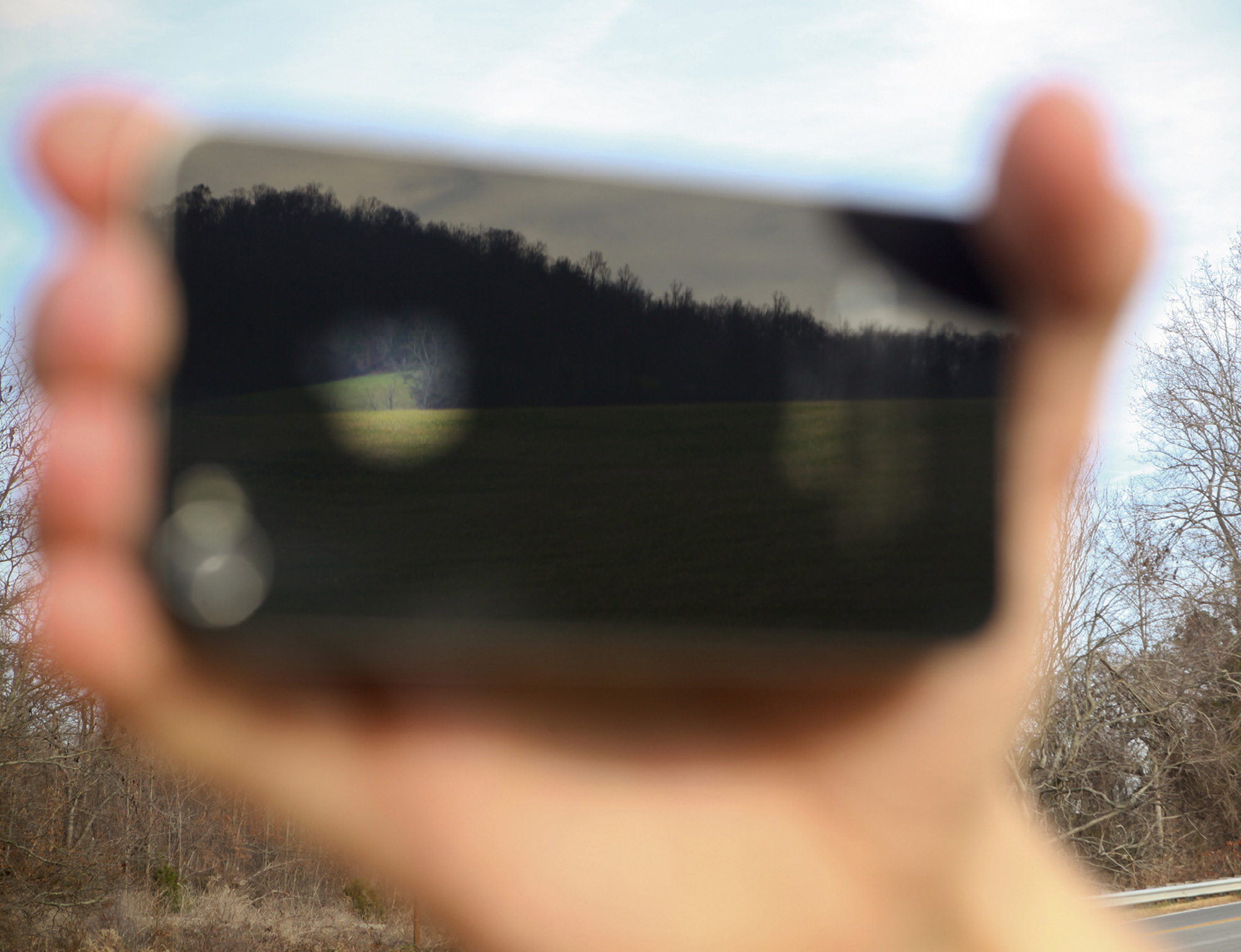Black Glass
Eye, phone
D. Graham Burnett

Wending his way upcountry from Uxbridge in July of 1791, Dr. John Watkins (“a Gentleman”) noted with suitably phlegmatic relish the pleasing hills and vales belonging to the Duke of Portland: “The mottled deer and large cattle demonstrate the goodness of the soil, as well as the smooth verdure of the vallies. My black mirror presented me with many beautiful landscapes in this park, that a Claude might not have disdained to copy.”[1]
Readers acquainted with late eighteenth-century visual culture will here recognize an allusion to that most peculiar optical technology of the Romantics—the “Claude glass,” a polished black or deeply colored opaque glass (sometimes plane, often slightly convex; generally palm-sized; nearly always oval or at least featuring rounded corners) used by travelers and artists to compose painterly plein-air views. Period satirists did not overlook the irony of such avidly touristical gazers diligently arranging themselves with their backs to any given charming vista, the better to study its virtues in the small, dark reflection of pocket mirrors held so as to peek over the shoulder. Seldom did the term preposterous (Latin praeposterous—i.e. “having the hinder parts forward,” hence absurd, contrary to sense, perverted) seem more literally apropos. But these volte-faced amateur and professional sightseers weathered such mockery in pursuit of specific aesthetic effects. Their quarry? The visual charisma of the eponymous Claude Lorrain, paradigmatic painter of the Romantic landscape, whose characteristic palette (a narrow, shady range of hue and value) found imagistic echo in the black glass. Claude glass in hand, one could see the world as a sequence of vignetted sketches by the master. And Sunday paintbox dabblers, arranged beneath their parasols, could suck the chroma from an excessively generous summer afternoon with nothing more than a flick of the wrist, thereby unifying and modulating each sunstruck scene.[2] An early technology of augmented reality? Or a precocious experiment with sensory deprivation? Yes, probably.
In The Claude Glass: Use and Meaning of the Black Mirror in Western Art, Arnaud Maillet helpfully situates these idiosyncratic instruments against a longer history of seeing in and through a glass, darkly—from classical catoptromancy to the tenebrous scrying mirrors of druidical witchcraft; from obsidian to Gilpin and back. Black magic aside, Maillet ultimately sees in the Claude glass a reflection of Jonathan Crary’s thesis (in Techniques of the Observer) that the early nineteenth century saw an epistemic-cum-scopic rupture in western Europe: a shift from a focus on the geometry of vision to a central concern with the physiology (and experience) of seeing. As a technology of spatial enframing and sensory transmutation—a kind of cross between a viewfinder and an Instagram algorithm—the Claude glass can be understood to sit strikingly on the watershed of optical modernity.[3]
Perhaps. But let us push past the modern, and concern ourselves, for a moment, with the veritable present.
I have in my hand at this moment a caseless black iPhone 4. We are familiar, it and I. Or were. Now, sharply, unsettlingly, I am not so sure. I have always thought it had a front (the screen, through which streams the accessible everything in a smooth shimmer of versicolor specks) and a back (the dead black glass). But this no longer feels quite right. I have misunderstood. It is two-faced, this thing—a strange lamination of eighteenth-century retrospection and twenty-first century introspection. I am in fact holding an instrument for looking backward and forward at the same time—an icon of progress that never ceases to gaze at the past.
Outside, the sun is setting through grey clouds. Rifts of red and yellow thread the heavy sky like hot magma cracking a field of fresh basalt. I read two glowing text messages, lively and green. Then, I flip the little Janus in my palm, put my thumb over the silver apple (so much was lost there), and watch the sky darken behind me.
Preposterous.
- Anonymous [John Watkins], “Observations, Natural, Oeconomical, and Literary, made in a Tour from London to the Lakes in the Summer of 1791,” The European Magazine and London Review, vol. 20 (July–December 1791), p. 137.
- “By such a reduction of the degree of brightness the effects of contrast, which are less perceptible in a strong light, are also brought out more vividly, and from these effects hints may be obtained as to the hues to be maintained.” Wilhelm von Bezold, The Theory of Color in Its Relation to Art and Art-Industry (Boston: L. Prang and Company, 1876), p. 225.
- Arnaud Maillet, The Claude Glass: Use and Meaning of the Black Mirror in Western Art (New York: Zone, 2004).
D. Graham Burnett is an editor of Cabinet and teaches history of science at Princeton University.
Spotted an error? Email us at corrections at cabinetmagazine dot org.
If you’ve enjoyed the free articles that we offer on our site, please consider subscribing to our nonprofit magazine. You get twelve online issues and unlimited access to all our archives.